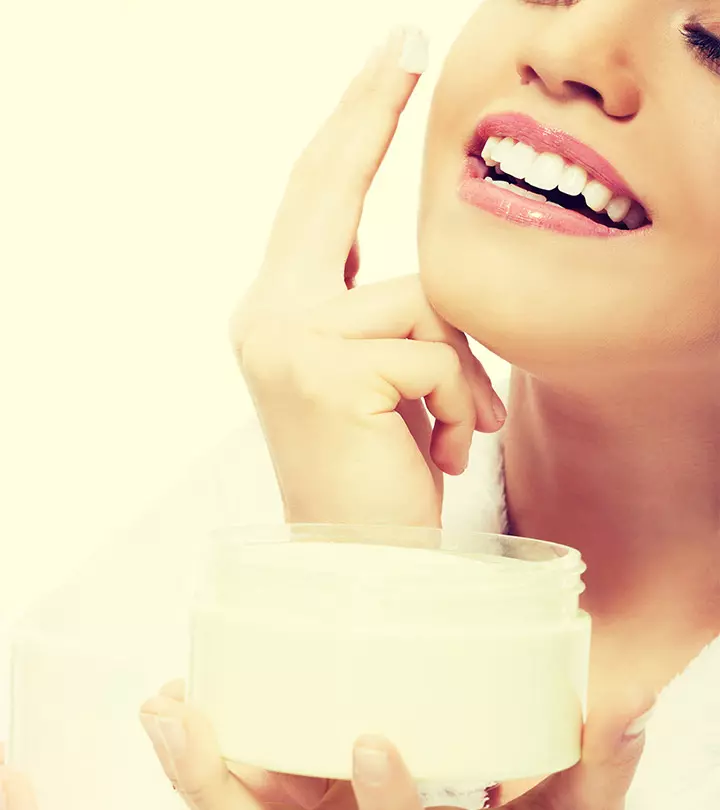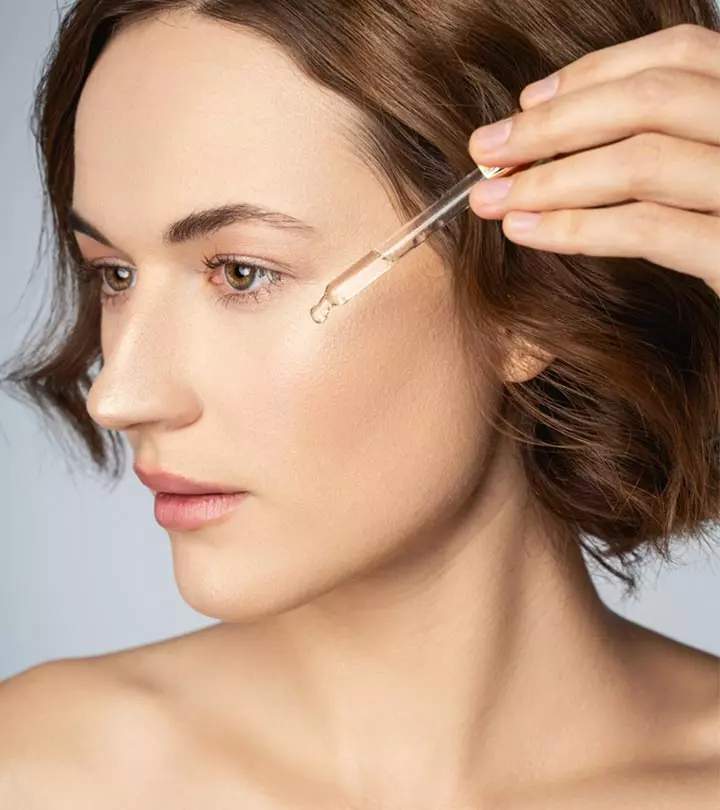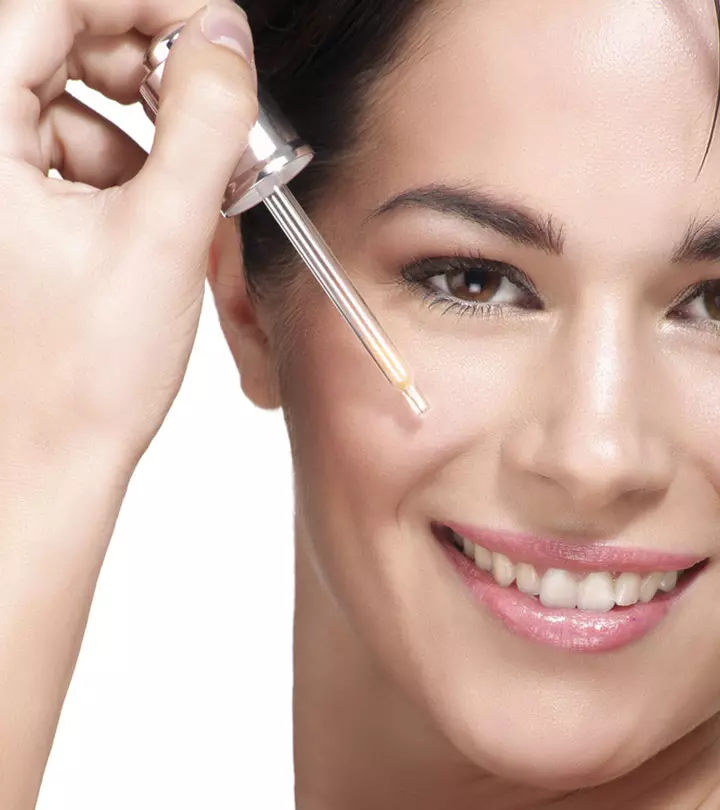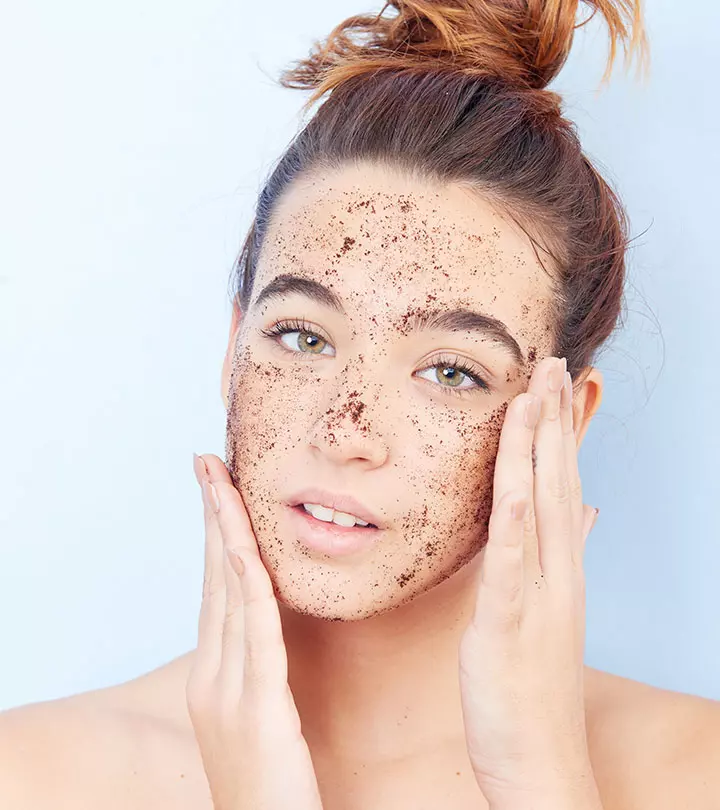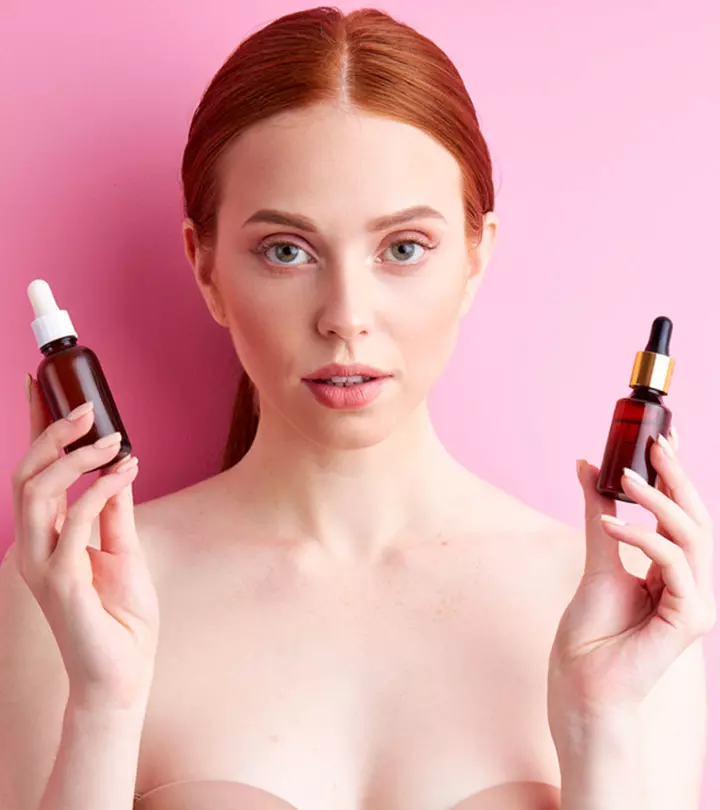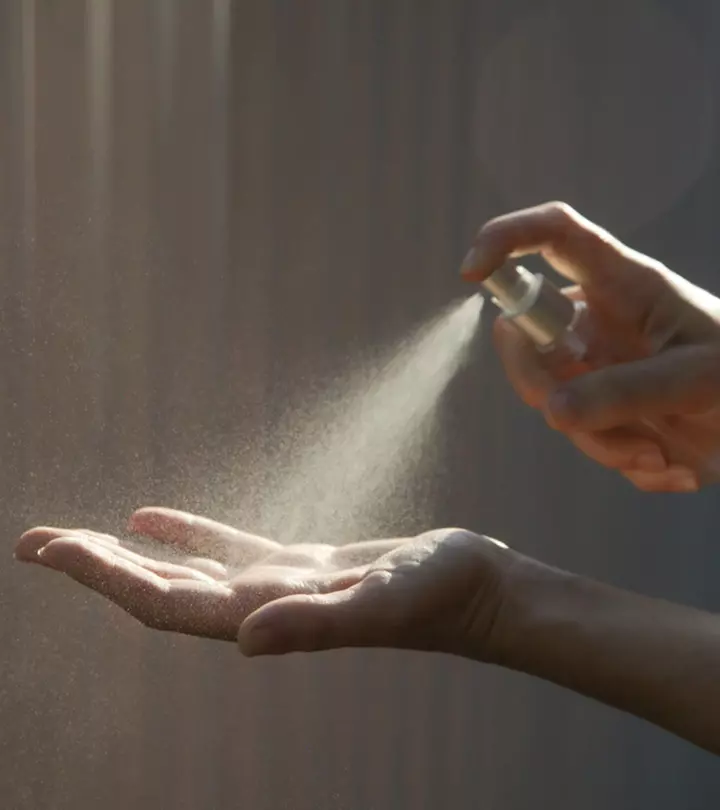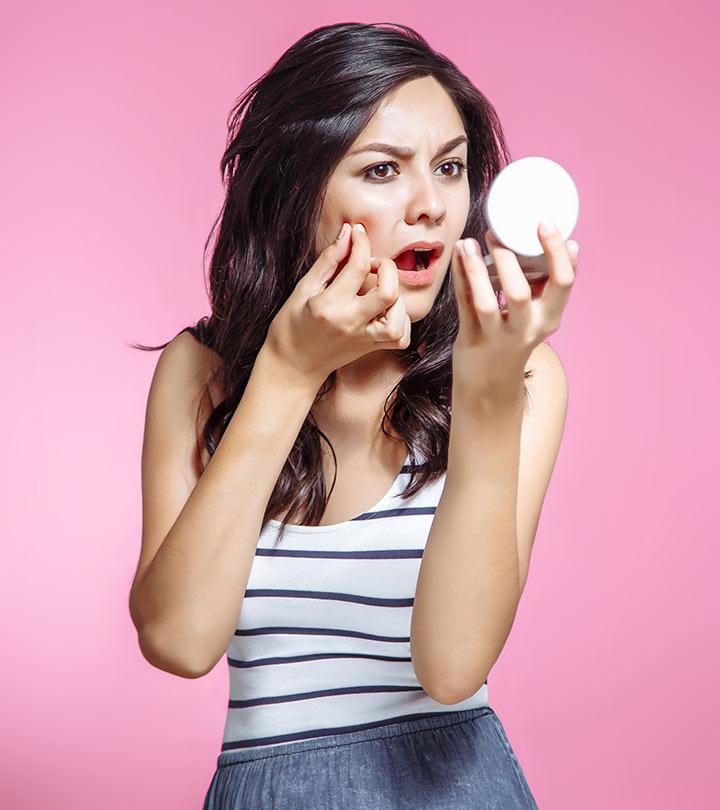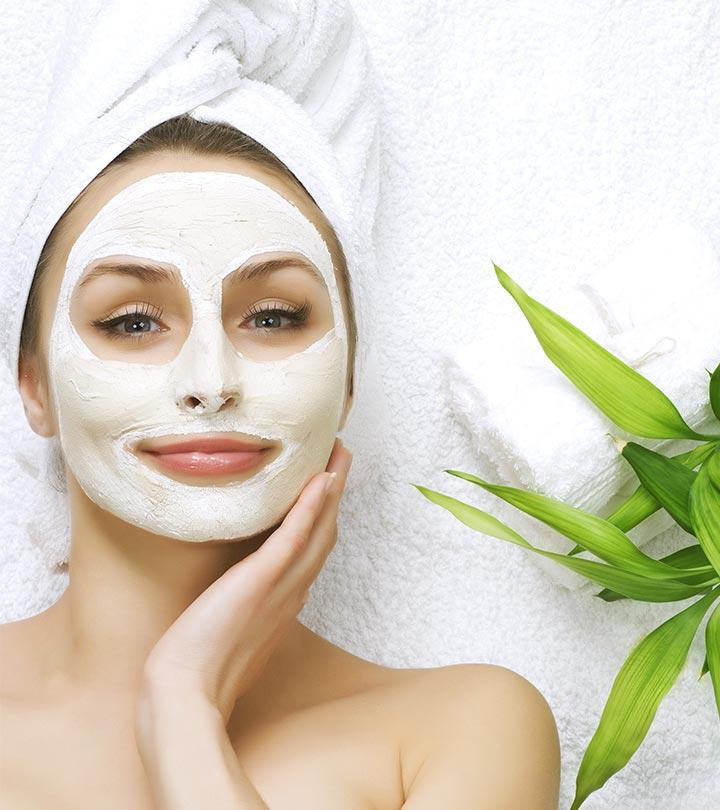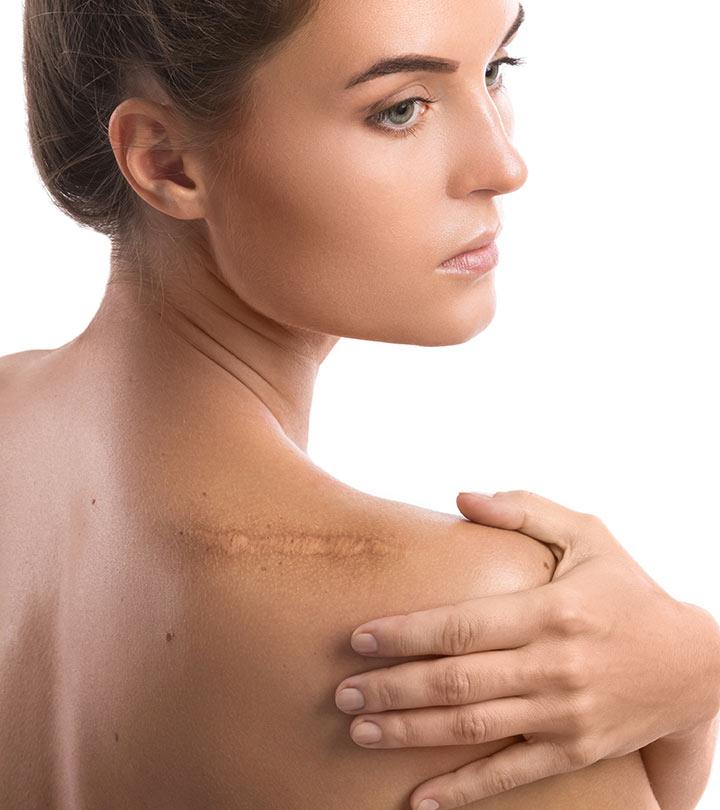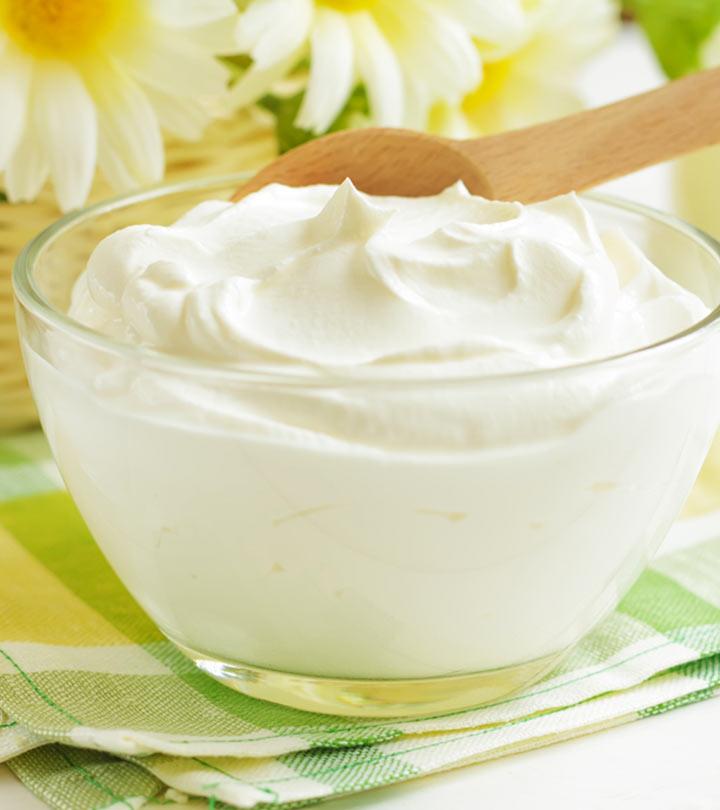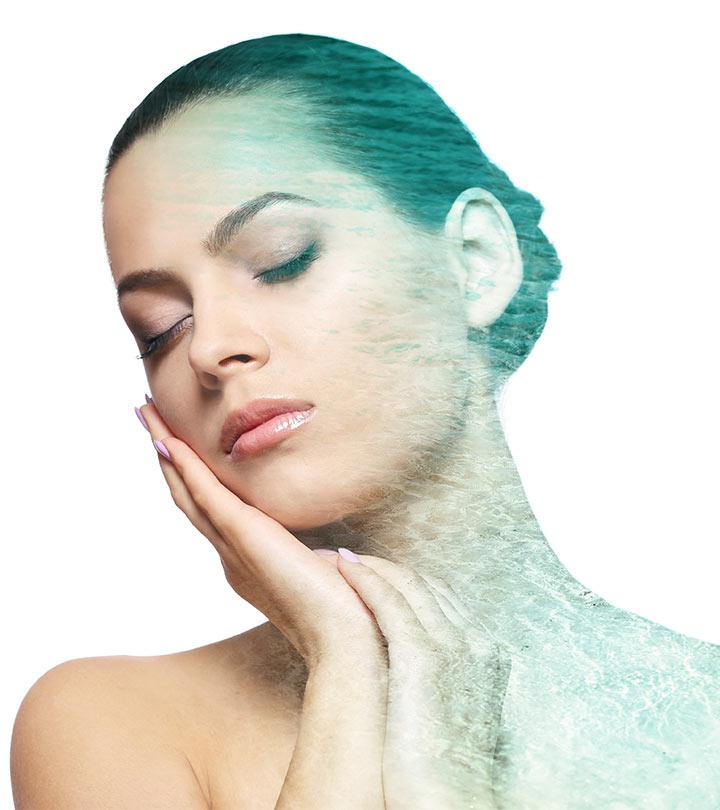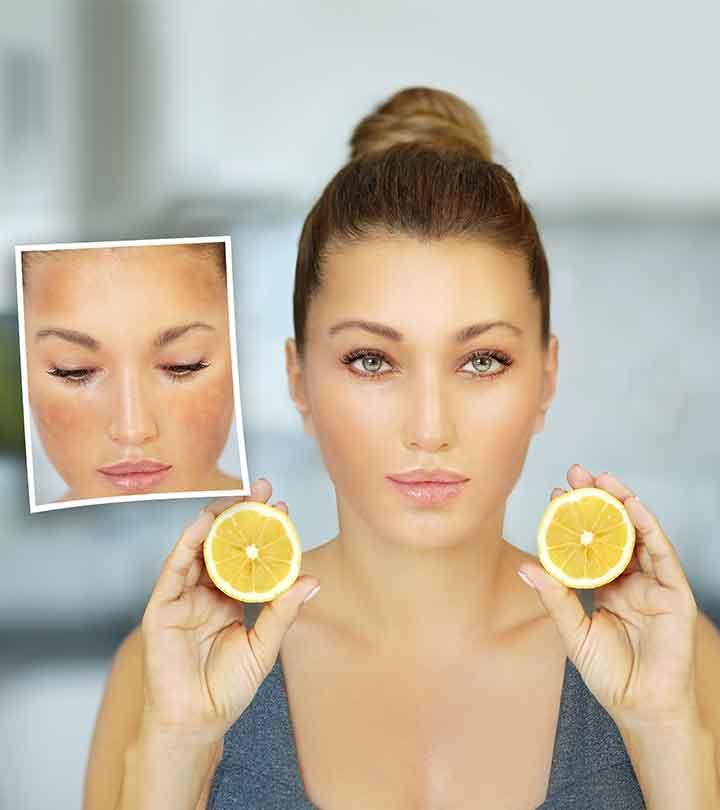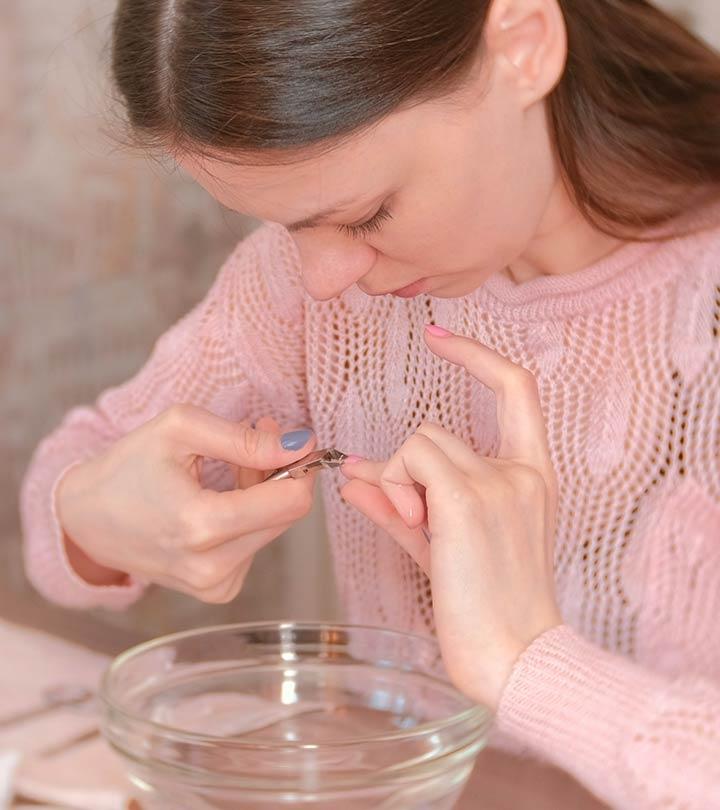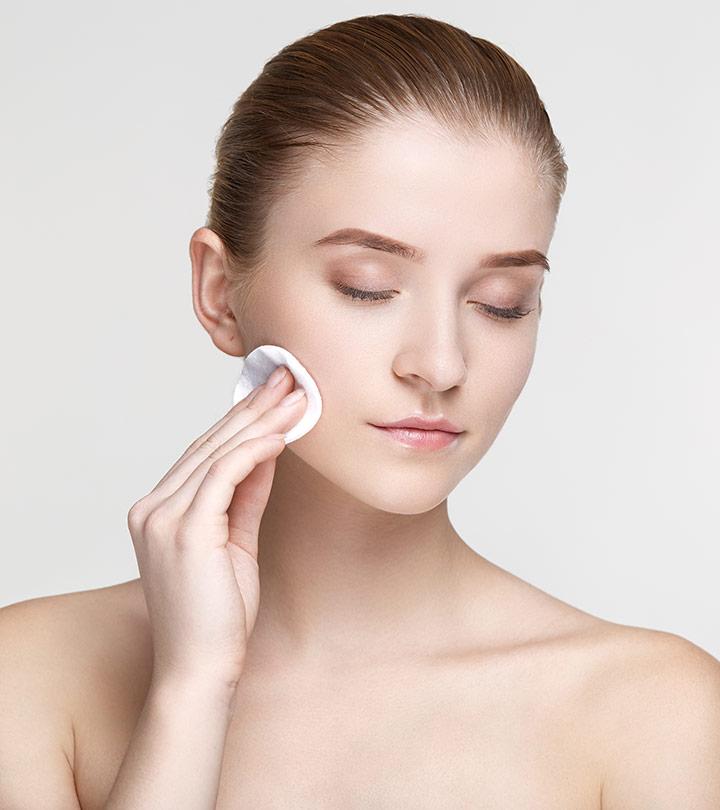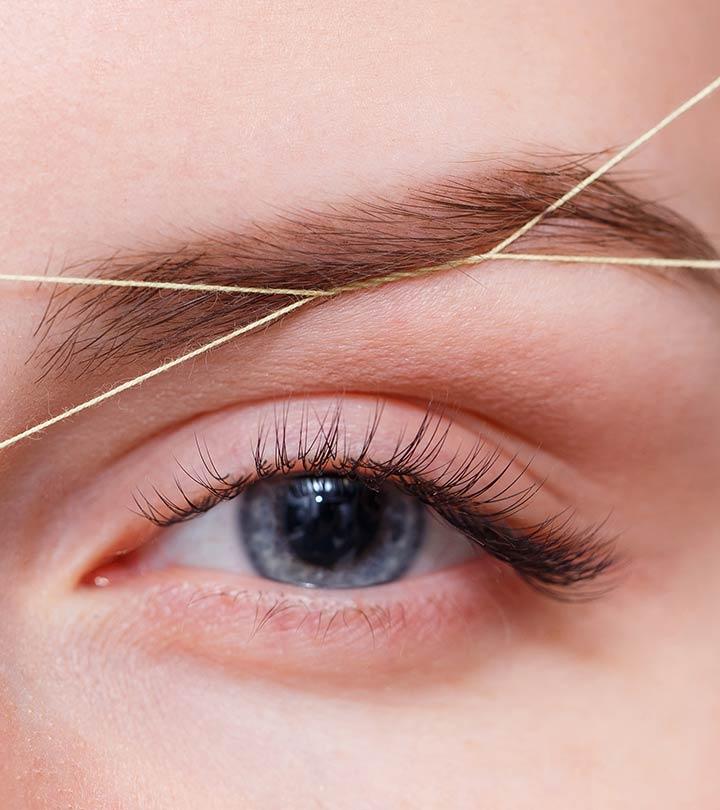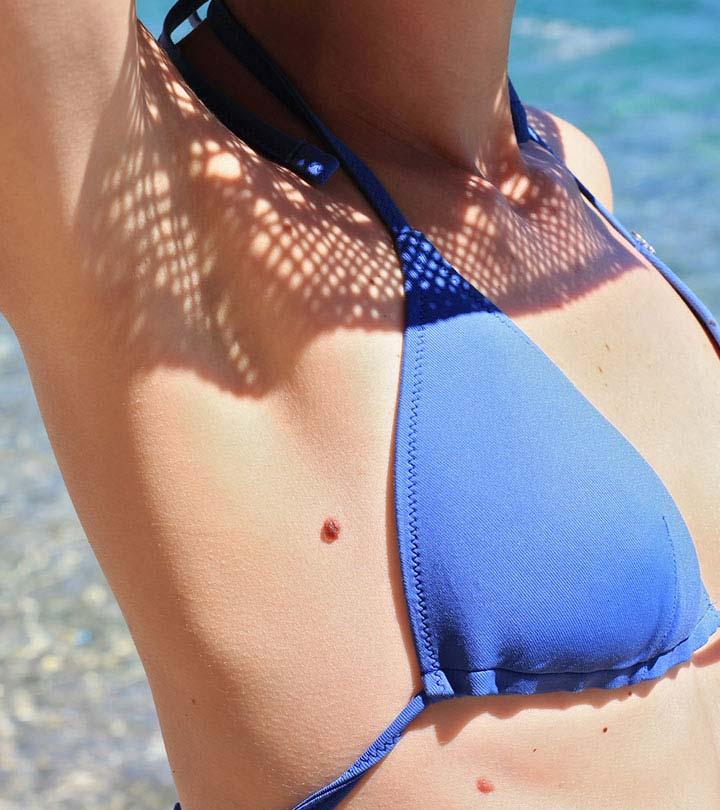Skin Care Acids Guide: How To Pick The Right Skin Care Acid
The simplified breakdown you needed to get started with the best exfoliators in town!
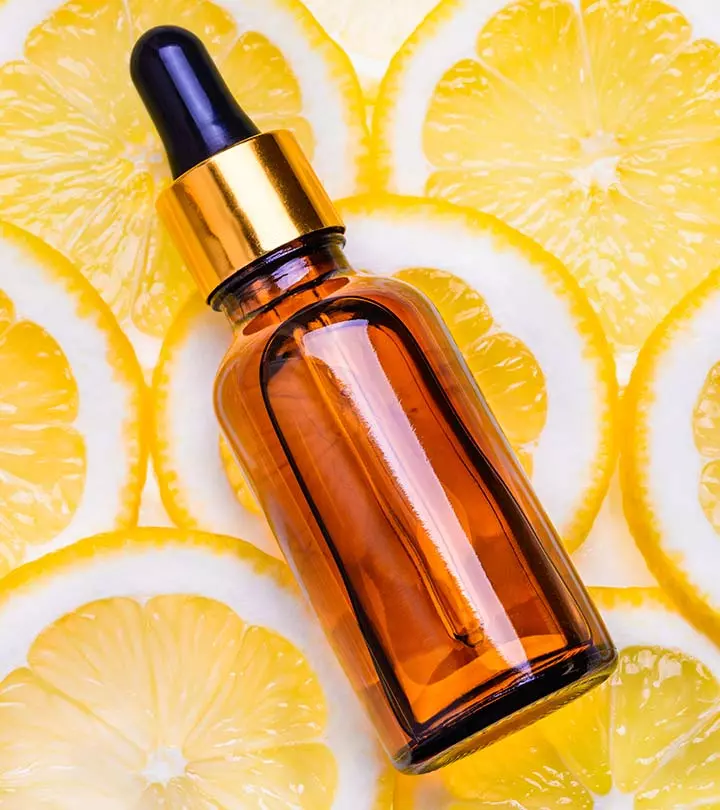
Image: Shutterstock
Owning the best skincare acids can give you the long-lasting radiance you have been waiting for. The common misconception about acids is, it corrodes your skin and is not suitable for your skincare. However, they have emerged as the most essential ingredients to remove hyperpigmentation and aid in skin brightening with time. If you are unsure what acid will help you according to your skin type and condition, we are here to help. Here is a complete guide to choosing the suitable acid for your skincare routine.
In This Article
A Guide To Skin Care Acids
Skin care acids are mainly of two types:
- Alpha Hydroxy Acids (AHAs)
- Beta Hydroxy Acids (BHAs)
While both the acids function as exfoliators, both are different and work differently on your skin.
For instance, AHAs (water-soluble acids, such as glycolic acid) exfoliate your skin by breaking down the dead skin cells on the surface while BHAs (oil-soluble acids, such as salicylic acid) sink deeper into your skin pores and unclog them.
Glycolic and salicylic acids are the two most common acids you will find in skin care products. However, some acids are neither AHAs or BHAs (such as azelaic acid), but they are good for your skin and can be found in skin care products. Let’s find out about all these types of acids and the skin types they suit.
1. Glycolic Acid
What Is It?
Glycolic acid is the most common alpha hydroxy acid used in skin care products, including chemical peels. It is usually derived from sugarcane. It gently exfoliates the skin and helps in reducing fine lines, wrinkles, and dark spots. It also improves skin texture and thickness and helps to even out the skin tone (1).
Suitable For
Glycolic acid can be used to brighten the skin and treat acne, acne scars, and hyperpigmentation. It is excellent for aging and mature skin (1). It is well tolerated by almost all skin types, especially oily skin. However, if you have sensitive skin, you should consult a dermatologist before trying glycolic acid.
 Quick Tip
Quick Tip2. Salicylic Acid
What Is It?
Salicylic acid is a beta hydroxy acid. It has comedolytic properties, which means it goes deep within the skin pores and unclogs them. Moreover, it helps in breaking down the topmost layer of your skin cells and dissolving the dead ones. That’s why it is very effective in treating acne and comedones (2).
A study was undertaken to understand the perspectives of adolescents on acne with 500 pupils who answered the questionnaire, out of which 234 (46.8%) were boys and 266 (53.2%) were girls. Acne was self-reported in 49.8% (249) pupils, while 50.2% (251) did not report acne. The factors that they pointed out as the aggressors were improper facial care (85.0%), hormonal changes (84.0%), consuming sweets (82.0%), junk food (72.6%), use of makeup (71.2%), and stress (67.8%). They believed that cosmetic treatment (80.4%) might provide some relief.
Include a salicylic acid serum the next time you head out to buy your regular skin care products or get professional chemical peels done for better results.
Suitable For
Salicylic acid is especially beneficial for oily and acne-prone skin. However, salicylic acid is also a salicylate, and its structure is similar to that of aspirin (acetylsalicylic acid) (2). Therefore, if you are allergic to aspirin, avoid salicylic acid.
3. Azelaic Acid
What Is It?
Azelaic acid is a saturated dicarboxylic acid, which naturally occurs on your skin. It is produced by a yeast that stays on your skin. It can also be found in wheat, rye, and barley and is an excellent exfoliator. It is very popular for treating acne and has anti-inflammatory properties (3). Apart from acne, it also helps in reducing skin pigmentation.
Suitable For
Azelaic acid suits all skin types, including sensitive skin. It is excellent for reducing inflammation, and anyone who has rosacea can use this acid for reducing the symptoms and calming their skin (4).
4. Mandelic Acid
What Is It?
Mandelic Acid is an AHA that works like magic in treating acne, melasma, wrinkles, and hyperpigmentation (5). It is also said to improve the quality of aged skin by improving its elasticity (6).
Suitable For
Mandelic acid takes time to penetrate your skin, and this makes it ideal for sensitive skin. It is good for dry skin as it keeps it moisturized by increasing sebum production. This property makes it unsuitable for oily skin. Also, together with salicylic acid, mandelic acid works well for those with darker skin tones and skin discoloration issues.
 Trivia
Trivia5. Lactic Acid
What Is It?
Lactic acid is also an AHA and a gentle exfoliator. This acid is an effective skincare ingredient usually found in milk, and that’s why in ancient times, women preferred taking milk baths. Applying lactic acid on the skin improves its firmness and makes it smooth (7).
Suitable For
If you have dry skin and are looking for something to keep it moisturized, you can try lactic acid. This acid also works excellent on mature skin and prevents fine lines and wrinkles.
6. Kojic Acid
What Is It?
Kojic acid is produced by different types of fungi, especially Aspergillus oryzae (called Koji in Japanese). It is also a by-product during the fermentation of rice wine and soy sauce. Kojic acid is used in skin care for its skin brightening properties (8). It can reduce the appearance of sun-induced damage, age spots, blemishes, and scars and has anti-aging effects.
Suitable For
Kojic acid gives you visible results, but on the flip side, it can also irritate your skin if it doesn’t suit you. It can also make your skin prone to sunburn. So, kojic acid should be used very carefully. It is better to consult a dermatologist to see if it suits your skin or not and know the correct way to use it on your skin.
7. Hyaluronic Acid
What Is It?
Also called hyaluronan, this is a substance that is naturally produced by your body. It is mostly found in your connective tissues, skin, and eyes. It helps to keep your skin moisturized by binding water, thereby preventing premature aging (9). Environmental stress and sun exposure can affect the levels of hyaluronic acid in your body, especially your skin. You need to use HA skin care products to prevent this decline.
Suitable For
Hyaluronic acid offers great skincare benefits for all skin types. However, if you have dehydrated and mature skin, you need to include this acid in your skin care routine. It helps to keep aging skin plump and firm by boosting hydration levels.
The blogger wrote about her experience with skincare acids and admitted that initially, she was shocked and wondered why anyone would use an acid on the skin. She says, “I found out that hyaluronic acid was one of the friendliest acids, and that is the first skincare acid I tried with my skin.” She used a 2% hyaluronic acid and felt that her skin was turning softer, smoother, and plumper. She then used Salicylic acid to combat breakouts and added, “Because I had oily skin, I knew I had to give salicylic acid a shot. What I loved about this product was the fact that it works to go deep into the pores while unclogging them (i).”
8. Ascorbic Acid
What Is It?
Ascorbic acid or vitamin C is an essential vitamin and a potent antioxidant that helps to reduce skin issues, such as hyperpigmentation, and protects it from oxidative stress and free radical damage. This often speeds up skin aging and causes inflammation (10).
Suitable For
Ascorbic acid suits almost every skin type and is especially suited for skin that struggles with hyperpigmentation. This powerful antioxidant is beneficial for brightening your skin and boosting collagen synthesis. Ascorbic acid or vitamin C is beneficial for mature skin.
9. Malic Acid
What Is It?
Malic acid is a type of AHA that your body produces naturally. Like other AHAs, malic acid helps your skin retain moisture. This, in turn, promotes skin cell turnover rate, which means that your skin cells are renewed at a faster pace, reducing the appearance of fine lines and wrinkles. This also softens the skin and improves its texture.
Suitable For
Malic acid is best suited for mature, sensitive, and combination skin types. It doesn’t irritate the skin and gently exfoliates it to make it visibly smoother.
10. Ferulic Acid
What Is It?
Ferulic acid is a hydroxycinnamic acid, a compound that is usually found in plant cells. Like vitamin C, this compound has antioxidant properties and is a free radical scavenger. It protects and heals some of the most important structures of your skin, including elastin, collagen, keratinocytes, and fibroblasts (11).
Suitable For
It is ideal for mature skin and those looking for anti-aging creams and acids. Also, if your skin is prone to sun damage, you can use this acid to protect your skin.
11. Retinoic Acid
What Is It?
Retinoic acid or retinoids are derivatives of vitamin A. They have shown excellent results in treating aging skin and preventing the effects of photoaging, such as wrinkles and hyperpigmentation. They also improve skin thickness (12).
Suitable For
Retinoic acid or retinoids suit almost all skin types, except for sensitive skin. Always consult a dermatologist to know the concentration and the correct ways to use retinoids on your skin. You might have come across many skincare tips that include using serums and creams on damp skin but keep in mind you don’t want to do it with retinoic acid. Only apply it when your skin is completely dry to prevent it from any reactions.
12. Phytic Acid
What Is It?
Phytic acid, also known as inositol hexaphosphate, is a naturally occurring compound found in various plant-based foods like grains, legumes, and seeds. It is among the mildest acids employed for chemical peeling and has a minimal exfoliating effect on the skin. Hence, it’s commonly combined with other acids to enhance their efficacy. Phytic acid helps promote skin brightness, diminishes the visibility of dark spots, and reduces free radical damage (13).
Suitable For
Phytic acid is suitable for most skin types, particularly hyperpigmented, acne-prone, or sun-damaged skin. It can help exfoliate, brighten, and improve skin texture. However, a patch test is advisable to be done on sensitive skin.
When you start using face acids, you can expect to see results within the first two weeks. However, if you are new to the world of acids, it is better to consult a dermatologist before trying any new acid-based product on your face. If you have any questions on your mind, feel free to post them in the comments section below.
Frequently Asked Questions
What skincare acids can be used together?
You can combine both AHA and BHA acids. This combination is perfect for combination skin because they tend to have both dry and oily areas on the skin. Hence, AHAs can be used on dry patches and BHAs on oily areas. However, consult a dermatologist before including any acid in your skincare routine.
What skin acids should not be used together?
Do not mix retinoic acid (retinoids) and ascorbic acid (vitamin C) with your AHAs and BHAs like salicylic acid or glycolic acid. Since they are all potent exfoliating acids, they will throw off the pH balance of the skin and have an extremely drying effect. However, you can leave a 40 minute gap between applications to let your skin’s pH get rebalanced. Additionally, it is ideal to use retinoids in your night routine for an overnight healing process and vitamin C in your morning routine followed by a broad spectrum sunscreen.
Is glycolic acid better than vitamin C?
Both glycolic acid and vitamin C address different skincare issues. Vitamin C protects the skin from harmful UV rays while glycolic acid helps reduce signs of aging and hyperpigmentation (1), (10).
Can you use 10% glycolic acid every day?
If you are a beginner, start with glycolic acid in concentrations under 5% twice a week. Your skin needs to build tolerance against the acid first. If you do not experience any adverse effects, you may increase to nightly application after a month and gradually increase the concentration to 10%. Higher concentrations need to be administered by skilled dermatologists.
Which is better for the skin: hyaluronic acid, or salicylic acid?
This depends on your needs. If you are aiming for smooth and hydrated skin, hyaluronic acid is perfect because it attracts water and improves the skin’s hydration. Salicylic acid helps soothe skin inflammation, making it ideal for acne-prone skin (2), (9).
Which is better: retinol or salicylic acid?
Both ingredients address different skincare issues. Retinol improves the appearance of fine lines and wrinkles while salicylic acid helps in cell regeneration and reduces acne (2), (12).
Key Takeaways
- That acids corrode the skin is a misconception. The truth is they help with skin exfoliation and unclog pores, improving the skin’s texture.
- They have active ingredients such as alpha hydroxy and beta hydroxy acids, which make dull and lifeless skin bright and glowing.
- They reduce the appearance of fine lines and wrinkles, lighten acne scars, and protect from sun damage.
- Glycolic, salicylic, kojic, azelaic, hyaluronic, and ascorbic acids can make your skin look brighter and smooth.
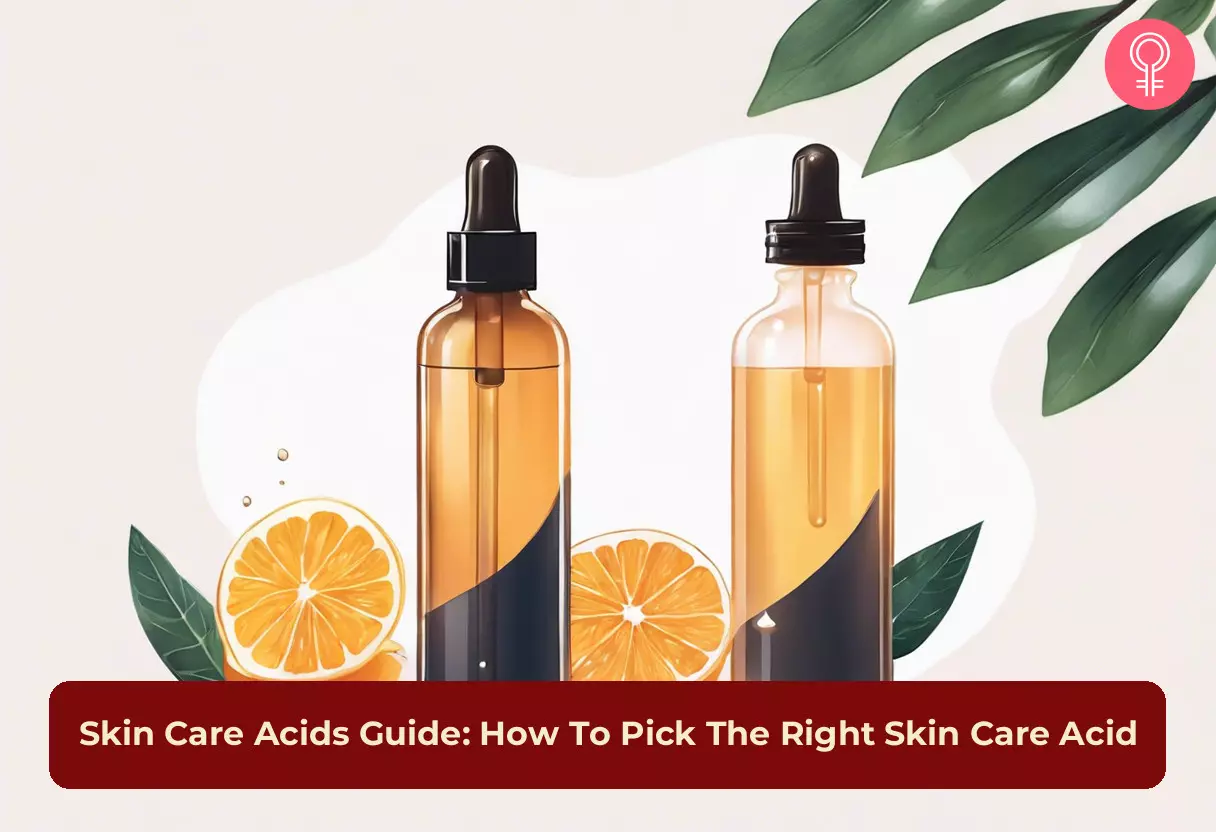
Image: Stable Diffusion/StyleCraze Design Team
Learn how to use safe acids in your skincare routine for glowing, healthy skin! Get the ultimate guide to using acids to achieve your best skin ever. Watch the video below to know more!
Personal Experience: Source
StyleCraze's articles are interwoven with authentic personal narratives that provide depth and resonance to our content. Below are the sources of the personal accounts referenced in this article.
i. Skincare Acids and Me!https://adiandbolga.medium.com/skincare-acids-and-me-8d6896b5cfa0
References
Articles on StyleCraze are backed by verified information from peer-reviewed and academic research papers, reputed organizations, research institutions, and medical associations to ensure accuracy and relevance. Read our editorial policy to learn more.
- “Glycolic acid peel therapy..” Clinical, Cosmetic and Investigational Dermatology, US National Library of Medicine.
- “Salicylic acid as a peeling agent..” Clinical, Cosmetic and Investigational Dermatology, US National Library of Medicine.
- “Azelaic acid. A review of its pharmacological..” Drugs, US National Library of Medicine.
- “Azelaic acid 15% gel in the treatment..” Expert Opinion on Pharmacotherapy, US National Library of Medicine.
- “Summary of Mandelic Acid..” Cosmetic Dermatology.
- “Effects of Topical Mandelic Acid..” Facial Plastic Surgery, US National Library of Medicine.
- “Epidermal and dermal effects of..” Journal of American Academy of Dermatology, US National Library of Medicine.
- “Depigmenting Effect of Kojic Acid..” Journal of Biomedical and Biotechnology, US National Library of Medicine
- “Hyaluronic acid..” Dermato Endocrinology, US National Library of Medicine
- “Vitamin C in Dermatology” Indian Dermatology Online Journal, US National Library of Medicine
- “Antioxidant Properties of Ferulic Acid..” Skin Pharmacology and Physiology, Karger
- “Retinoids in the treatment of skin aging..” Cinical Interventions in Aging, US National Library of Medicine
- “Efficacy and safety of a new peeling..” Journal of Cosmetic Dermatology, US National Library of Medicine
Read full bio of Dr. Vindhya L Veerula
Read full bio of Eshna Das
Read full bio of Shiboli Chakraborti






